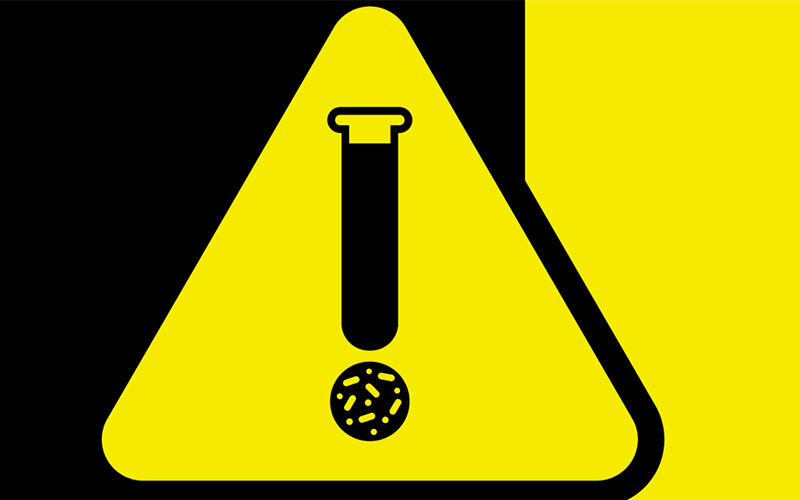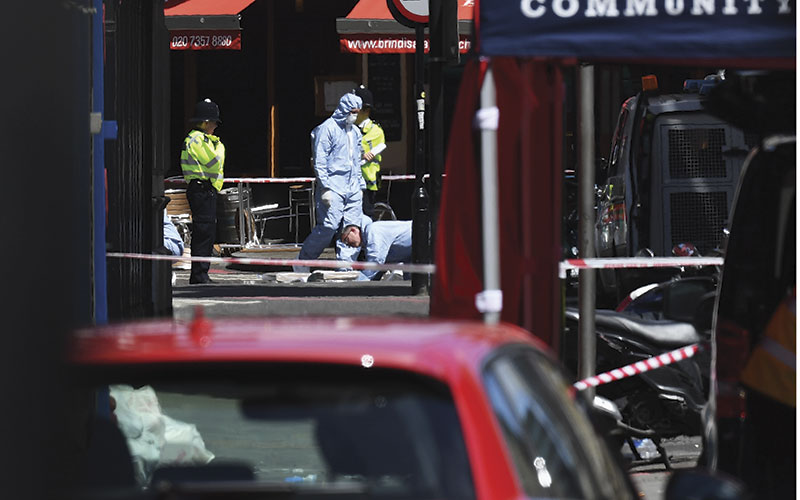Dervilla Gorman and Naomi DeJager describe their roles as bronze commanders at Viapath Analytics and discuss their responses to incidents that have affected pathology services.

An incident in the diagnostic laboratory refers to an unplanned event that causes or has the potential to cause a minor or major disruption to the normal provision of pathology services.
Incidents that take place internally within the hospital or laboratory environment have a varied impact on pathology services, which can range from an extended turn-around time of pathology test results to the inability to perform specific tests until the problem has been completely resolved. Hospital systems are put under considerable strain when external disasters occur and, in some instances, the infrastructure devised to minimise disruption becomes overwhelmed.
Natural disasters, the outbreak of an infectious disease, major transport accidents and acts of terrorism are all examples of events which can adversely affect hospitals and their pathology services. It is vital that all laboratories have a strategic system in place to cope with these challenging situations, so that problems are quickly resolved without major disruption and a rapid return to normal services can be achieved.
Strategic responses
A Gold-Silver-Bronze command structure is used by Viapath Analytics at Guys and St Thomas’ NHS Hospital Trust (GSTT) to establish a hierarchical framework for the management of major and minor incidents that can potentially affect the provision of its 24/7 pathology service.
It is the responsibility of the senior biomedical scientist working in the specialist haemostasis and thrombosis laboratories to take on the role as bronze commander outside of core hours.
The bronze commander is the first point of contact on-site in response to the incident and is responsible for co-coordinating the operational response. They report directly to the Viapath Silver commander and the site nurse practitioner of the host trust, to enable an appropriate response and further escalate if necessary.
Having a bronze commander on-site outside of core hours unites the individual pathology sections that normally work independently of each other (e.g. chemistry, haematology, microbiology). They are personally informed of the incident and get regular updates and support until the incident has been resolved.
Unnecessary pressure is removed from vital sections, such as transfusion, which needs to focus on issuing blood products without being disturbed, as the bronze commander becomes the primary contact for the site nurse practitioner, information technology technician and silver commander, among others.
Methodology
Data analysis of incident reports recorded by bronze commanders over a five-year period (2014 to 2018) with emphasis on the type of incident, the action taken and the final outcome.
Results
IT failure was the most frequent type of incident (43%), followed by analyser breakdown (20%), environmental issues (13%), sample transport issues (9%) and MERS/VHF/EBOLA (7%). The least common incidents were police investigations (1%), broken fridges/freezers (2%), critical staff shortages (2%) and trust major incidents (3%). Following is an analysis of four incidents, outlining the incident, response and outcome.
Case study 1: Total IT failure
Incident: The laboratory information management system (LIMS) used by blood sciences, cellular pathology, blood transfusion, and microbiology ceased to work in the early hours of Saturday morning. This system provides streamlined tracking and routing of specimens, the verification of key patient demographics and the electronic communication of test results to clinical areas. Central specimen reception was unable to book in samples; samples were being delivered to the laboratory without barcodes and results could not be authorised or accessed by clinical staff.
Response: The bronze commander informed the site nurse practitioner and the off-site silver commander and contacted the on-call IT support. All pathology sections reverted to paper requests and emergency numbers in order to process urgent tests. The site nurse practitioner issued a clinical alert message to all wards informing them of the situation and asking them to send urgent requests only together with handwritten referral forms in an effort to reduce the workload and to assist with emergency numbers. At 07:30 the bronze commander advised extra staff to be called in to assist central specimen reception and blood sciences. A detailed handover was carried out between bronze commanders at the 09:00 shift change, to allow continued support to blood sciences, and an update provided to staff, silver command and site nurse practitioner at 09:45. The bronze commander maintained regular contact during the downtime, until a server reboot occurred at 15:00. Unfortunately, this was unsuccessful and downtime continued while a conference call was conducted with technical support in USA.
Outcome: LIMS connectivity was finally restored at 20:40, after being down for 17 hours and 40 minutes. The problem had been caused by a file running and disrupting the application. All pathology sections were personally informed by the bronze commander, so that they could start clearing the backlog. The site nurse practitioner issued a clinical alert notifying clinical areas that all pathology services were back to normal.

Incident: Both Roche Cobas e 602 chemistry analysers, which are responsible for tests including renal-liver-bone profiles, broke down before midnight on a Thursday. The biomedical scientists were unable to get them to work and an engineer was unable to attend until the following morning. A high volume of A&E, ITU and other urgent samples had built up needing chemistry tests.
Response: The bronze commander, in conjunction with the two on-duty chemistry biomedical scientists, decided that one biomedical scientist should relocate and open the “core-hours-only” chemistry laboratory at Guys hospital (1.5 miles away) to process samples while the second biomedical scientist would remain at St Thomas’ hospital site to organise the incoming samples. A taxi was organised to take the scientist to Guys hospital site at 01:30 on Friday morning. The normal courier service between Guys and STH was increased in frequency and reversed so that samples were taken to Guys (instead of the usual from Guys). The bronze commander kept the site nurse practitioner and silver commander fully informed and a clinical alert was sent out to alert the wards of a delay in chemistry results.
Outcome: The Roche Cobas e 602 chemistry analyser at Guys was set up and processing of samples from both sites commenced by 04:00. A Roche engineer promptly arrived at STH at 08:00 Friday morning to fix the analysers, which were back in service by 11:30.
Case study 3: External major incident
Incident: The trust operator released a speech message via the bleep system to the Viapath bronze commander at 22:30 on a Sunday night, indicating a major incident alert. This was followed shortly by a declared major incident at 22:46. Key staff were asked to report to the emergency department immediately.
Response: The Viapath bronze commander informed all pathology sections (transfusion, haematology, chemistry and central specimen reception) of the initial alert and on investigation, it was discovered that a terrorist attack had taken place at London Bridge. The off-site silver Commander was informed of the situation and was kept in contact throughout. Four patients needed transfusions due to multiple stabbings and chest injury. Flying squad blood was issued. Additional staff were called in to support transfusion.
Outcome: The pathology section most affected by this major incident was blood transfusion. One of the biomedical scientists was sent to A&E to issue
blood products to guarantee their correct use and avoid wastage. Although she performed an outstanding service, the situation clearly traumatised her and after the incident was stood down at 05:15, the bronze commander advised her and communicated to the silver commander that she may need counselling to come to terms with her experience. This was arranged soon after the event.
Case Study 4: Flooding
Incident: The site nurse practitioner informed the Bronze commander on Saturday morning that Cellular pathology had been flooded due to a burst pipe on the floor above. The extent of the damage was unknown, because laboratory doors were locked as this department does not require weekend cover.
Response: The off-site silver commander was contacted, who instructed the bronze commander to assess the extent of the damage. Security staff were authorised to unlock the laboratory doors to allow access to the bronze commander and the rapid response team to clear up the water. Water was still dripping from the laboratory ceiling, but soon stopped. The water was mainly located on the right hand side corridor and only a small area of one of the laboratories was affected, offices and laboratories were mainly untouched. Boxes and bins sitting in the water were relocated. The off-site silver commander and the SNP were informed of the flood location and that it was manageable and had not caused extensive damage.
Outcome: The actions of the Bronze commander outside of core hours ensured that damage was minimised, and service delivery could resume with no delay on Monday morning.
Conclusion
A total of 119 incidents with the potential to impact service delivery have taken place outside of core hours over the past five years at Viapath Analytics. Internal incidents occurred in 97% of cases with IT issues being the most problematic and major external incidents occurred in just 3% of cases. This study highlights the advantage of having an experienced bronze commander on-site supporting all areas of pathology when dealing with incidents. It also highlights their important role as a single point-of-contact in resuming normal pathology services in all areas with minimal disturbance.
Dervilla Gorman and Naomi DeJager are Bronze Commanders working outside of core hours at Viapath Analytics (Guys & St Thomas’ Hospital). They would like to thank Operations Manager Jacky Cutler for inspiring this article and the haemostasis team at Viapath Analytics for their dedication and commitment as bronze commanders outside of core hours.
Picture credit | Getty




